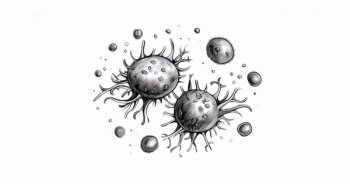
Pacritinib Shows Transfusion Independence Benefits in Myelofibrosis
During a Targeted Oncology™ Case-Based Roundtable™ event, Bart Scott, MD, discussed JAK inhibitor options and the data from the PERSIST-2 trial of pacritinib. This is the first of 2 articles based on this event.
Targeted Oncology: Could you summarize the approved Janus kinase (JAK) inhibitors for patients with myelofibrosis?
BART SCOTT, MD: Ruxolitinib (Jakafi) was approved in 2011, fedratinib (Inrebic) in 2019, pacritinib (Vonjo) in 2022, and momelotinib (Ojjaara) in 2023. Ruxolitinib has survival benefit and was studied in the front line.1 Fedratinib was studied in the front line and second line and has more gastrointestinal [GI] toxicity.2 I tend to prefer it for second line. Pacritinib [is for patients with] platelet counts less than 50,000/μL.3 Momelotinib [is for patients with] symptomatic anemia, generally hemoglobin less than 10 mg/dL [and was] compared with danazol.4 There was an upfront trial, SIMPLIFY-1 [NCT01969838], where momelotinib was compared with ruxolitinib, and it didn’t meet its primary end points.5 Outside of the setting of anemia, I don’t think momelotinib should be the preferred drug. I would favor ruxolitinib. A lot of the studies were stopped early. Fedratinib was stopped early because of Wernicke encephalopathy.2 Pacritinib had an FDA hold because of cardiovascular events and bleeding.3
All of these are JAK inhibitors. All of the patients with myelofibrosis have upregulation of the JAK-STAT pathway. There is no evidence that being triple negative [for JAK2, CALR, or MPL alterations] impairs sensitivity to any of these agents. I’ve been referred patients who were MPL positive, and [the referrer said], “They don’t have a JAK2 mutation, so I didn’t think I should give them a JAK inhibitor.” I admit our language about this is not good; it’s probably better to think of these as JAK-STAT pathway inhibitors, and it’s probably better to think about these diseases as all sharing in common upregulation of the JAK-STAT pathway.6
What is known about pacritinib’s effectiveness in patients with transfusion-dependent anemia?
Transfusion independence with pacritinib [is] not something that you hear a lot about, but pacritinib may be more effective than momelotinib in improving hematopoiesis. If you look at comparing pacritinib overall with other best available therapy [BAT], pacritinib was more likely to result in transfusion independence.7 If you look at the transfusion independence conversion rate [through week 24], it was 37% for pacritinib, compared with only 7% for BAT [P = .001]. Pacritinib may solve both problems [anemia and thrombocytopenia] at the same time. If you look at the rate of 50% transfusion reduction [at week 24, it was 49% with pacritinib vs only 9% with BAT [P = .0001].
What data supported the approval of pacritinib in patients with myelofibrosis?
Pacritinib was approved based off a subset analysis of PERSIST-2 [NCT02055781]; this was for patients with a platelet count less than 100,000/μL. There were 3 arms, but we are [focusing on] pacritinib 200 mg twice a day. That is the approved [dose] of pacritinib. Most of these patients received ruxolitinib as BAT, [but] I like to say they had suboptimally dosed ruxolitinib, because what are you going to do with the platelet count goes less than 100,000/μL? You’re going to dose reduce. You need to take a [sufficient dose of a] medication for it to work.
In the data from PERSIST-2, they saw similar spleen volume reductions with 200 mg and 400 mg [once daily].8 That’s why 200 mg twice a day is the FDA-approved dose.9 Looking specifically at the patients with a platelet count of less than 100,000/μL, the response rate was 29% in the pacritinib arm compared with only 3% in the BAT arm, which is why this drug was FDA approved for spleen volume responses.8 Looking at total symptom scores [TSS], we have data for pacritinib 200 mg twice a day compared with BAT, and pacritinib was better than the BAT [32% vs 14%, respectively, in patients who had 50% improvement in TSS].
Looking at the red blood cell transfusions over time, in the 200 mg twice a day pacritinib arm, the red blood cell transfusions units per month was less than what you see with BAT and less than the pacritinib 400 mg once a day arm. The other interesting thing that they saw is that if you look at the change in platelet count over time, it was better with pacritinib 200 mg twice a day compared with BAT.
What toxicities were observed in patients who received pacritinib in the trials?
[Toxicities included] GI adverse events because it is a FLT3 inhibitor…and nausea, anemia, and thrombocytopenia. I am not very [concerned with infections] with any of these [JAK inhibitors], and I don’t give prophylactic antimicrobial agents unless they already have a history of breakthrough herpes simplex virus. I had a patient who died of miliary tuberculosis, so tuberculosis is an issue, but I don’t think you routinely screen patients for that. In the clinical trial, we did [check electrocardiograms for QTc prolongation] but as routine standard of care, I do not.
References:
1. Jakafi. Prescribing information. Incyte Corporation; 2023. Accessed January 11, 2024.
2. Inrebic. Prescribing information. Bristol-Myers Squibb; 2023. Accessed January 11, 2024.
3. Vonjo. Prescribing information. CTI BioPharma Corp; 2022. Accessed January 11, 2024.
4. Ojjaara. Prescribing information. GlaxoSmithKline; 2023. Accessed January 11, 2024.
5. Mesa RA, Kiladjian JJ, Catalano JV, et al. SIMPLIFY-1: a phase III randomized trial of momelotinib versus ruxolitinib in Janus kinase inhibitor-naïve patients with myelofibrosis. J Clin Oncol. 2017;35(34):3844-3850. doi:10.1200/JCO.2017.73.4418
6. Duminuco A, Torre E, Palumbo GA, Harrison C. A Journey Through JAK Inhibitors for the Treatment of Myeloproliferative Diseases. Curr Hematol Malig Rep. 2023;18(5):176-189. doi:10.1007/s11899-023-00702-x
7. Oh ST, Mesa RA, Harrison CN, et al. Pacritinib Is a potent ACVR1 inhibitor with significant anemia benefit in patients with myelofibrosis. Blood. 2022;140(suppl_1):1518-1521. doi:10.1182/blood-2022-156936
8. Mascarenhas J, Hoffman R, Talpaz M, et al. Pacritinib vs best available therapy, including ruxolitinib, in patients with myelofibrosis: a randomized clinical trial. JAMA Oncol. 2018;4(5):652-659. doi:10.1001/jamaoncol.2017.5818
9. FDA approves drug for adults with rare form of bone marrow disorder. FDA. March 1, 2022. Accessed February 6, 2024.







































